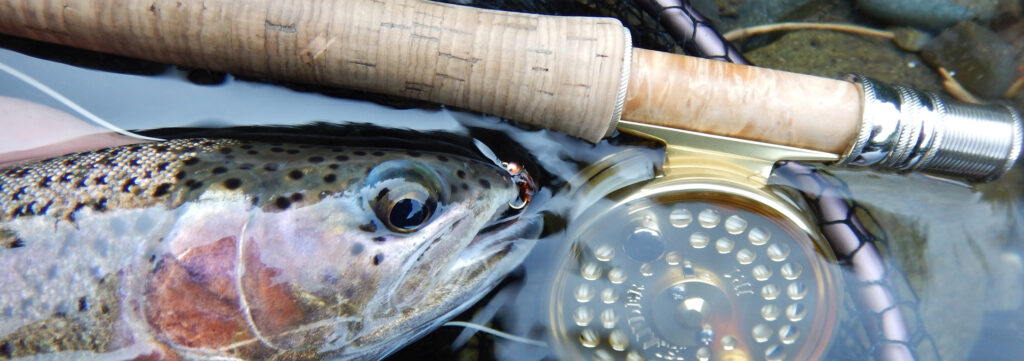Nymphs are the immature forms of some aquatic insects. Fishing with nymphal patterns, or nymphing, in trout streams is one of the most successful methods to catch fish. However, many anglers are intimidated by it, and see it as something complicated – which it is not. With a typical fly-fishing outfit (fly reel, nine-foot fly rod, and floating fly line) you can improve your nymphing by focussing on these five basic elements:
1. Ditch the tapered leader
Tapered leaders, essential for dry-fly fishing, are not needed for nymphing. The weight of nymph patterns turns over the leader, and since you want your fly close to the stream bottom, the thick back end of a tapered leader slows down the sinking of your nymph. To avoid this problem, build a very simple leader with two sections of level line. Use six feet of eight-pound-test Maxima Chameleon for the back end, and connect it to six feet of six-pound-test fluorocarbon using a tippet ring or small swivel (size 14 or smaller).

2. Fish your nymphs close to the bottom
Insect nymphs and trout live close to the bottom of streams. Naturally, if you plan to fish nymphs, you have to keep your fly where both the prey and predator are. To do this, ensure your nymphs are adequately weighted. If you tie your own nymphs, use tungsten beads and include a few wraps of lead wire. You can also place split shot, which are great for getting your fly down, two feet above the fly on your leader. As you get more nymphing experience you might stop using them, but they are great tools to start out with.
3. Use floating strike indicators
Strike indicators take years off the nymphing learning curve. They are also fun to use, as they make fishing very visual. Use a floating ball-style indicator. To start, attach the indicator six feet above the fly, then adjust the indicator closer or further away from the nymph, as needed, to ensure the fly is fished close to the bottom. When you fish this setup, you may need to mend your fly line to prevent drag; try to get the indicator to drift at the same speed as the current, not faster.
4. Simplify it to one or two patterns
Since the buggy-looking Beadhead Pheasant Tail Nymph resembles most stonefly and mayfly nymphs, it is one of the most widely used and effective nymph patterns. Fish this fly in sizes as large as 8 to as small as 14. As an alternative, many anglers also favour the Gold Ribbed Hare’s Ear Nymph.

5. Fish close, and fish the obvious spots
There is no need to make long casts when nymphing. Successful anglers seldom cast more than 20 feet, and are not afraid to fish their nymphs close by. Focus on fishing the transition zones between fast- and slow-moving water that are two feet or deeper. You can find these transition zones, called seams, around obstructions such as boulders. Look for foam lines, as they often reveal seams. Even if you do not see any obvious obstructions in the river, fish the foam line or wherever you see a clear separation between fast- and slow-moving water. Also, target those transition zones when water suddenly changes depth. A good example of this is where a shallow riffle flows into a pool or run.
Nymphing is addictive. Like any new fishing technique, it can be a little tough to learn initially, but once you have figured it out, you will be hooked. Keep it simple, and as you gain more experience, expand your repertoire with other nymphing methods and flies.
Author: Danie Erasmus
Photo Credit: Danie Erasmus
Danie Erasmus lives in Prince George. In his spare time, he writes articles about fishing on streams, and operates a website: www.princegeorgeflyfisher.com dedicated to educating anglers about fly fishing. Danie also teaches a number of fly-fishing courses that range from beginner to more advanced levels.
